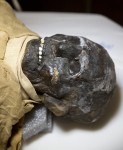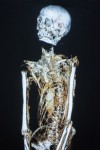 The mummy of a 6th century Egyptian stone cutter that has been on display at the Massachusetts General Hospital in Boston since 1823 was removed from his sarcophagus for a professional cleaning on Friday, June 7th. His name is Padihershef and salts used in the mummification process have been gradually seeping out of him for centuries. Peabody Essex Museum conservator Mimi Leveque was contracted to remove the salt deposits from his face and linens. She used cotton swabs moistened with saliva — looks like Mom was right all along about saliva’s face cleaning properties — to wipe the salts off his blackened visage, small brushes and a vacuum to remove dust and dirt from the surface.
The mummy of a 6th century Egyptian stone cutter that has been on display at the Massachusetts General Hospital in Boston since 1823 was removed from his sarcophagus for a professional cleaning on Friday, June 7th. His name is Padihershef and salts used in the mummification process have been gradually seeping out of him for centuries. Peabody Essex Museum conservator Mimi Leveque was contracted to remove the salt deposits from his face and linens. She used cotton swabs moistened with saliva — looks like Mom was right all along about saliva’s face cleaning properties — to wipe the salts off his blackened visage, small brushes and a vacuum to remove dust and dirt from the surface.
Leveque’s work was open to the public from 11:00 AM to 3:00 PM in the Ether Dome, a historic operating theater where the first public use of inhaled ether as an anesthetic took place on October 16th, 1846. The Ether Dome began its historic run as an operating room in 1821; Padihershef moved in two years later after he was given to the museum by the city of Boston. The city had received him as a gift from Dutch merchant Jacob Van Lennep, the Netherlands Consul General in Smyrna, Ottoman Empire, who donated the mummy so it could “be given to some pubic establishment as a mark of respect to that city.”
Van Lennep’s company did a great deal of business in the US — it imported the first cargo of figs into the country — but it’s unclear why Van Lennep went to so much trouble to acquire a mummy for Boston. He asked his cousin Lee, the British Consul in Alexandria, to score him a mummy and when Lee couldn’t find any good ones in Alexandria or Cairo, he sent a dogsbody to Thebes to dig up a new one. Padihershef was in excellent condition and was considered the best mummy to have been found in decades.
 His elaborately decorated sarcophagus told us most of what we know about him. Padihershef was a bachelor, son of father Iref-iaen-Hershef and mother Her-ibes-enes. He worked in the City of the Dead in Thebes, tunneling into cliffs to make tombs for the wealthy. Born on August 5th, 662 B.C., he was in his 40s when he died.
His elaborately decorated sarcophagus told us most of what we know about him. Padihershef was a bachelor, son of father Iref-iaen-Hershef and mother Her-ibes-enes. He worked in the City of the Dead in Thebes, tunneling into cliffs to make tombs for the wealthy. Born on August 5th, 662 B.C., he was in his 40s when he died.
Van Lennep sent Padi to Boston on the ship Sally Ann along with his standard shipment of raisins, wool, rugs and opium. He arrived at Boston Harbor on April 25th, 1823, and was given to the hospital on May 4th. Padihershef was the first mummy ever shipped to the United States, as far as we know. He caused a sensation and was promptly put to use raising funds for the hospital which charged the curious 25 cents a visit. He was briefly leased to an oddities impresario who took him on a tour of American cities so visitors could pay $2.50 to catch a glimpse of him.

 With the exception of that tour, Padi’s has resided in the Ether Dome for almost 200 years. He and his coffin have been standing vertically in cases in the front of the operating theater and both the body and the sarcophagus need some touching up. This conservation project began in March after an anonymous donor gave Mass General $5,000 to examine Padihershef in detail. He’s been X-rayed at the hospital before, once in 1931 and once in 1976. Both historical X-rays indicated stunted bone growth from severe childhood illness, but there’s so much more data that can be revealed with X-rays today and CT scans collect information in three dimensions about soft tissues as well as bones. In fact, the March
With the exception of that tour, Padi’s has resided in the Ether Dome for almost 200 years. He and his coffin have been standing vertically in cases in the front of the operating theater and both the body and the sarcophagus need some touching up. This conservation project began in March after an anonymous donor gave Mass General $5,000 to examine Padihershef in detail. He’s been X-rayed at the hospital before, once in 1931 and once in 1976. Both historical X-rays indicated stunted bone growth from severe childhood illness, but there’s so much more data that can be revealed with X-rays today and CT scans collect information in three dimensions about soft tissues as well as bones. In fact, the March  scans discovered that there’s a broom handle inside Padi’s torso, possibly the result of some long-forgotten conservation attempt to keep his head attached to the body. The team hopes to find out more about Padi’s life, diet, illnesses and death this time around.
scans discovered that there’s a broom handle inside Padi’s torso, possibly the result of some long-forgotten conservation attempt to keep his head attached to the body. The team hopes to find out more about Padi’s life, diet, illnesses and death this time around.
Experts are working to restore and stabilize his coffin and linens. Once he’s clean and composed, Padi will go on temporary display at the George Walter Vincent Smith Art Museum in Springfield, Massachusetts, after which he will return to the Ether Dome. He and his coffins will be placed in new horizontal custom designed display cases which will be much more comfortable for them since they won’t have to fight gravity.